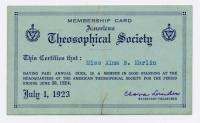Alma Karlin: Difference between revisions
No edit summary |
No edit summary |
||
| Line 19: | Line 19: | ||
[[File:Karlin Membership Card.jpeg|right|200px|thumb|Karlin's Membership Card]] | [[File:Karlin Membership Card.jpeg|right|200px|thumb|Karlin's Membership Card]] | ||
Karlin was admitted as a member of the [[American Theosophical Society]] of the Honolulu, Hawai'i Lodge on July 1, 1922. She continued as a member through June, 1924, when her address changed to "Tokio, Japan."<ref>Membership Ledger Cards. Microfilm roll 4. Theosophical Society in America Archives.</ref> | Karlin was admitted as a member of the [[American Theosophical Society]] of the Honolulu, Hawai'i Lodge on July 1, 1922. She continued as a member through June, 1924, when her address changed to "Tokio, Japan."<ref>Membership Ledger Cards. Microfilm roll 4. Theosophical Society in America Archives.</ref> | ||
[[File:Alma Karlin Maximiliana in Japanese dress.png|right|200px|thumb|Alma Karlin wearing Japanese dress]] | |||
== Travels == | |||
== Writings == | == Writings == | ||
Revision as of 23:08, 20 November 2024
Alma Vilibalda Maximiliana Karlin (12 October 1889 – 15 January 1950) was a Slovene traveler, writer, poet, collector, polyglot and theosophist. She was one of the first European women who circled the globe alone. She said to her mother on November 24, 1919, when leaving on her journey:
I must go. Something inside me forces me to do this, and I will not find peace if I do not follow this force.
Personal life
Alma Karlin was born October 12, 1889 in Celje, Slovenia to Jakob Karlin and Vilibalda Miheljak. Her father died when Alma was only eight years old.
According a biographical sketch in the Alma Karlin Memorial House website:
Alma Maximiliana Karlin was born in Celje into a bourgeois family: her father was a major in the Austrian army, her mother, a teacher. In 1908, she left for London where she found a job in a translation office and studied languages. In 1914, she graduated from the Royal Society of Arts in 8 languages. In 1919, she embarked upon her famed travels around the world, which last continuously for 8 years. For a woman travelling alone, travelling at that time was something exceptional, even outrageous. She returned to Celje in 1927.
Upon her return, she taught, still travelled a lot, gave many lectures at home and abroad, wrote for various magazines, even her own literature. From 1921 and 1937 alone, she published 22 books in Germany, Great Britain, Switzerland and Finland. Swedish writer Selma Lagerlöf (1858–1940), the first female writer to win the Nobel Prize in Literature in 1909, even proposed her for a Nobel Prize. On one of her lectures in Stockholm in the early 1930s, Alma met the painter Thea Schreibner Gammelin (1906–1988) with whom she was bound by a lasting friendship, probably also by a lesbian relationship. In 1934, Thea, her "soul sister", came to live permanently in Celje and they remained inseparable until Alma's death. After World War II, they moved together into a small house in Pečovnik, today's Memorial House.[1]
On January 14, 1950, Alma died in Pečovnik, Celje, Slovenia. She was buried in a graveyard in Celje, where her companion, Thea Schreinbner Gammelin was also interred in 1988.[2]
Theosophical Society Involvement
Karlin was admitted as a member of the American Theosophical Society of the Honolulu, Hawai'i Lodge on July 1, 1922. She continued as a member through June, 1924, when her address changed to "Tokio, Japan."[3]
Travels
Writings
This author was best known for the travel and fiction novels that she wrote in German. They were very popular in the 1930s. Most are available in Slovenian and German, but not English.
Fiction
- The Odyssey of a Lonely Woman. London : Victor Gollancz, 1933.
- The Spell of the South Sea. This novel in two volumes was reprinted several times, over 100,000 copies.
Nonfiction
- The Death-Thorn: Magic, Superstitions, and Beliefs of Urban Indians in Panama and Peru. Translated by Bernard Miall. London: G. Allen & Unwin, 1934.
Other resources
- Alma Karlin in Wikipedia.
- Alma Karlin Web Portal.
- Alma Karlin Memorial House website for museum in Pečovnik, Slovenia.
- A Lonely Odyssey: The Life and Legacy of Alma M. Karlin. Posted July 7, 2023 on Orientations website.
- Gobetz, Milena. Alma Maximiliana Karlin: World-Famous Slovenian Writer, Ethnologist, Artist, and Composer. In Slovenian Heritage. Vol. 1 Willoughby Hills, Ohio: Slovenian Research Center of America, 1980.
- Vampelj Suhadolnik, Natasa. "A Lonely Odyssey: The life and Legacy of Alma M. Karlin." In Orientations Hong Kong Vol. 47, No. 3 (2016), 50-55.
Notes
- ↑ "History" in Alma Karlin Memorial House website.
- ↑ Findagrave.com.
- ↑ Membership Ledger Cards. Microfilm roll 4. Theosophical Society in America Archives.

